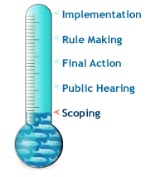The Gulf of Mexico Fishery Management Council will meet next
week at the Hilton in Galveston, Texas.
You’re welcome to join us in person or watch a livebroadcast of the meeting. This agenda will help you figure out when the Council
will be addressing the fisheries issues that interest you. Here are the
background materials you’ll need to follow along.
Public comment will be held from 2:30 – 5:00 pm on
Wednesday, October 7. Here is a quick
overview of some of the issues the Council plans to address:
Hint: The Council takes public comment at all times – not
just during meetings. If we’re working on a fishery issue and you want to share
your thoughts visit our “proposed amendments” page by clicking this thermometer
icon from our homepage www.gulfcouncil.org.
There you’ll find a variety of documents, guides, videos, and online comment
forms for each Amendment.
The Council expects
to take final action on a framework action that considers changing the gag
season and size limit and the black grouper size limit. Watch this video and
share your opinion before a decision is made.
Red Snapper
The Council will
review revised alternatives in Amendment 39: Regional Management – which considers dividing the recreational
red snapper quota among different regions in the Gulf to allow for the creation
of different management measures that best suit each area. Public hearings will be hosted in the coming
weeks at these dates and locations. We’ll post documents, guides, and videos to
this page when they’re ready.
Hogfish
 |
| Photo: Emily Muehlstein |
Mutton Snapper
The Council will review a framework action that considers
setting and annual catch limit, bag limit, and commercial trip limits for
mutton snapper.
South Florida Management
The Gulf Council, South Atlantic Council, and State of
Florida have been working on a fisheries management plan that aims to
streamline regulations in South Florida, particularly off of the Florida Keys.
The Council will review an options paper that considers modifying the
management structure and some management measures for yellowtail snapper,
mutton snapper, black grouper and shallow-water grouper, to make fishing
regulations less complicated for commercial and recreational fishermen in the
area.
The Council will review two public hearing drafts for
amendments that consider making some changes to king and Spanish mackerel
management. Amendment 26 considers making modifications to allocations, stock
boundaries and sale provisions of king mackerel, and Amendment 28 considers
separating permits for Gulf and Atlantic king and Spanish mackerel.
The Council will review a public hearing draft for Shrimp
Amendment 17A - which considers what to do about the pending expiration of the
federal shrimp permit moratorium. The Council expects to host public hearings
on this amendment in January.
The Council will also review a draft options paper for
Shrimp Amendment 17B – that considers establishing an optimum yield, target
number of permits, permit pool, and addressing transit provisions through
federal waters.




















